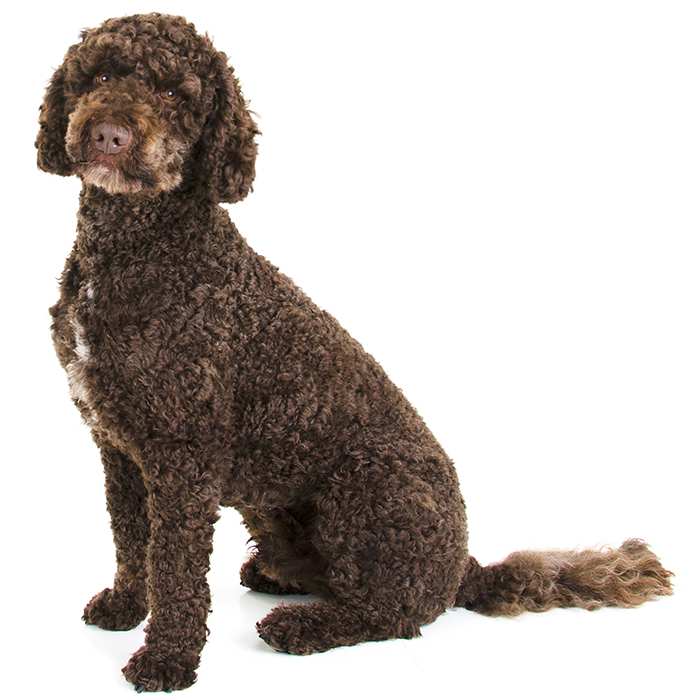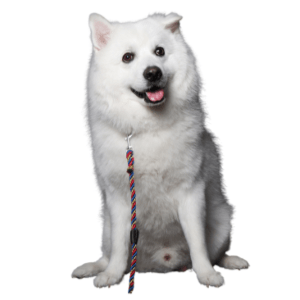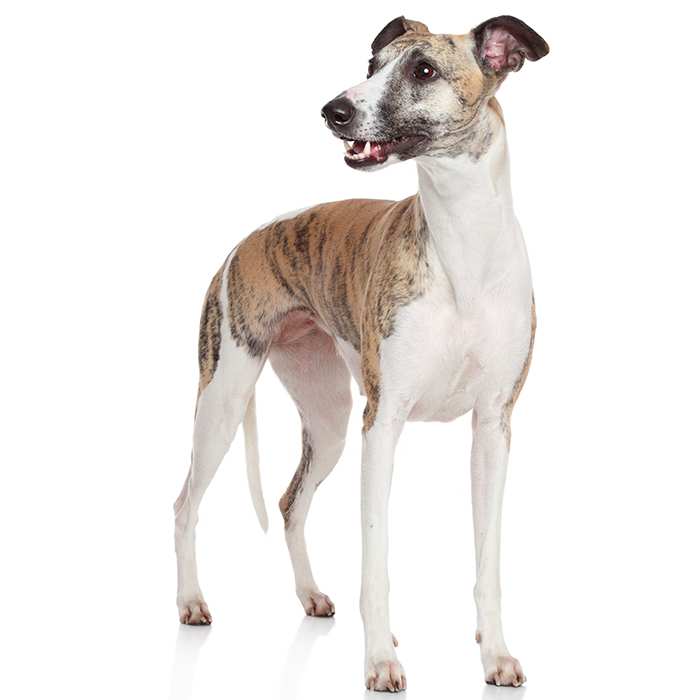Bloodhound
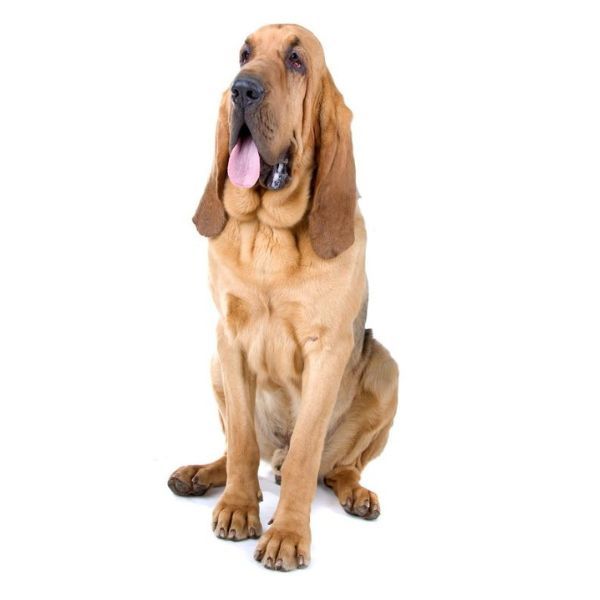

| Recommended for | Experienced owners and families |
| Breed Classification | Hound group |
| Other names | Sleuth Hound |
| Lifespan | 10-12 years |
| Size | Large |
| Temperament | Independent, loving, gentle |
| Intelligence | Average |
| Tendency to bark | High |
| Maintenance Level | Medium |
| Health Risk | This breed has an around average probability of having health issues in its lifetime, hence it is one of the more affordable breeds to insure. |
Insuring a Bloodhound?
Get our award-winning Nose-to-Tail Cover with up to $30k annual benefit limit, up to 90% of eligible vet bills back, and no sub-limits.
Get a quick quote
Is this breed right for you?
Try our breed selector quiz to find out your best matching breed!
Insuring a Bloodhound?
Get our award-winning Nose-to-Tail Cover with up to $30k annual benefit limit, up to 90% of eligible vet bills back, and no sub-limits.
Get a quick quote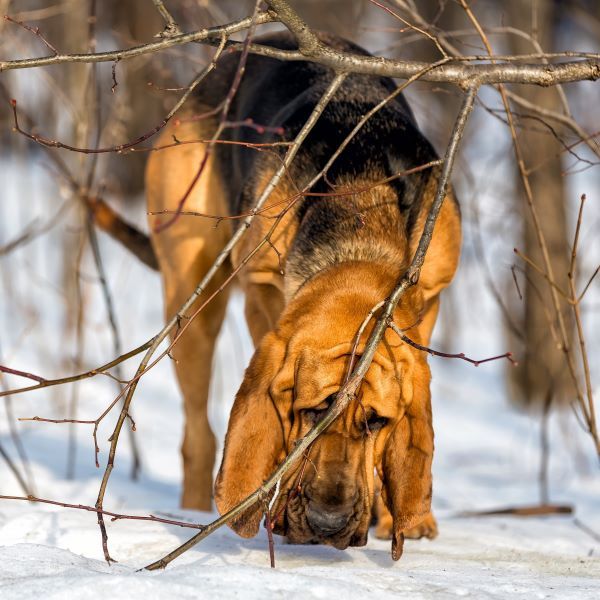
Breed history of Bloodhounds
There is little known about Bloodhound origins, but some authorities say the breed’s ancestry came from the ancient Mediterranean region. A third-century scholar mentions a hound of unrivaled scenting powers, so intensely devoted to the work that he could not be pulled off the trail until his quarry was found.
The Bloodhound we know today was perfected in Western Europe about a thousand years ago by high-ranking members of the church. In medieval times, when even bishops rode to hounds, packs of hounds were maintained on the grounds of the well-funded monasteries of England and France. The monks charged with executing the bishop’s breeding program executed it so diligently that their hounds came to be known as ‘blooded hounds’ – ‘blooded’ meaning ‘of aristocratic blood.’
With their excellent sense of smell, Bloodhounds were traditionally used to track down prey over long distances, but was not until the 16th century that the breed was used to track humans. Since then, the Bloodhound has earned a reputation as a man-trailer without equal. Police departments worldwide have relied on them to follow the scent of humans, including criminals and missing persons. Despite our advanced technology, no scenting device yet invented is as accurate as the Bloodhound’s nose.
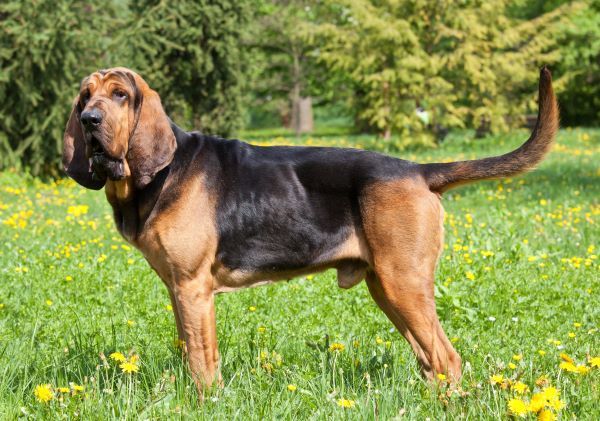
Physical description of Bloodhounds
Bloodhounds are large, muscular dogs with powerful legs that allow them to scent over miles of punishing terrain. Their most famous features are a long, wrinkled face, huge, drooping ears, and warm, deep-set eyes.
There is purpose to the Bloodhound’s more unusual features. Their long, low and floppy ears were bred this way to assist them with scent tracking – far longer than the muzzle, they sweep the scent toward the large nostrils. Their velvety skin is thin and loose, especially about the head and neck where it hangs in deep folds. This excess skin, and the slobber that accumulates on it, helps to trap the scent particles. Loose skin also protects them from rough vegetation when out on the trail.
Their coat is smooth, short and weatherproof, and comes in black and tan, liver and tan, and red. A small amount of white may appear on the chest, toes and tip of the tail.
| Weight range | Males 41 to 50 kg; females 36 to 46 kg |
| Height range | Males 63 to 69 cm; females 58 to 63 cm |
| Colours | Black and tan, liver and tan (red and tan) and red |
| Coat length | Short |
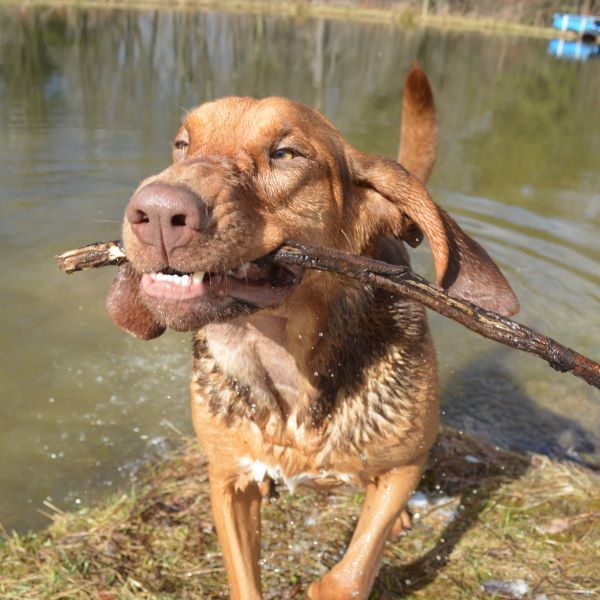
Bloodhound personality and temperament
An affectionate and extremely gentle hound, the Bloodhound is friendly with companions and other dogs, but can also be reserved and sensitive. They can be quite clingy towards their owners to the point of fixating on them, and are quite sensitive to any changes.
They can often be a bit unruly and seem to have a mind of their own, so good leadership and clear boundaries are a must for Bloodhounds to become good family dogs. They are not recommended for first time dog owners as their sense of smell can take them places you don’t want them to be. Obedience training is essential, but can be quite challenging.
Bloodhounds must have regular opportunities to vent their energy and do interesting things, otherwise they become rowdy and bored, which they usually express by baying and destructive chewing. Bored Bloodhounds can turn your house and yard inside out in a single day. They require a fully fenced yard, with a minimum height of about 5 ft, and need to be on-lead for any exercise taking place outside a secure area, as their wonderful nose often leads to trouble.
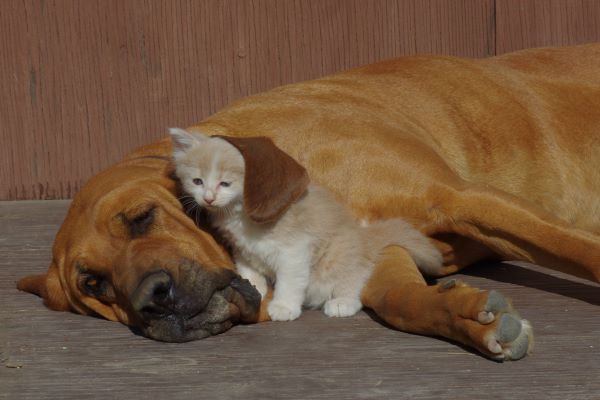
Bloodhounds with kids and other pets
As pack dogs, Bloodhounds enjoy company, including other dogs and kids. They are usually very good with children (although care must be taken with toddlers as they can potentially knock them over) and other animals.
Bloodhounds are seldom used for hunting any more, but some individuals still have strong instincts to chase and seize fleeing creatures, including small pets like cats, rabbits and birds. Some Bloodhounds can be dominant or aggressive toward other dogs of the same sex.
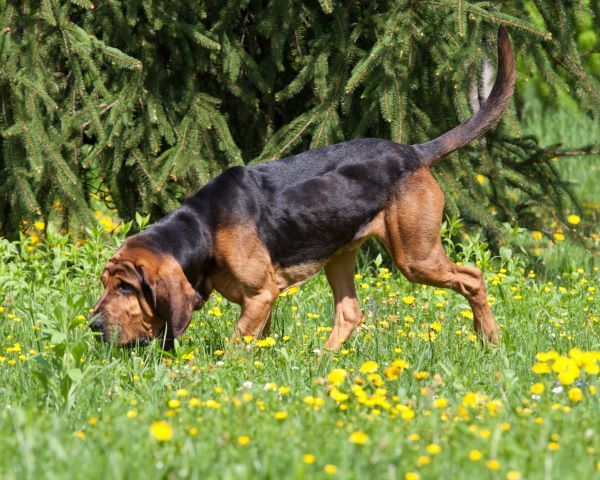
Bloodhound training and exercise
Bloodhounds, bred to follow a scent for hours on end, are active dogs that require long daily walks always on-leash, as it can be almost impossible to call them back if they have found a scent to follow. Additional exercise can take place in the backyard, which must be securely fenced because Bloodhounds are great diggers and escape artists. They also enjoy swimming, fetch and nose works games.
Obedience training can be a challenge. The Bloodhound is affectionate and devoted and also stubborn and independent, so training requires patience, consistency and skill. Owners needs to be firm but kind – training that involves positive rewards, such as treats and praise, is often effective – practised regularly, and made as much fun as possible. Bloodhounds are easily distracted, and training should be kept short, especially while they are young.
As with all breeds, early socialisation and puppy training classes are recommended. With this breed, it’s best to start obedience classes early; they tend to become set in their ways, and it’s better if the behaviours they are likely to hold onto for their lifetime are the behaviours their owner desires.
| Energy level | Moderate |
| Exercise requirements | Medium to high |
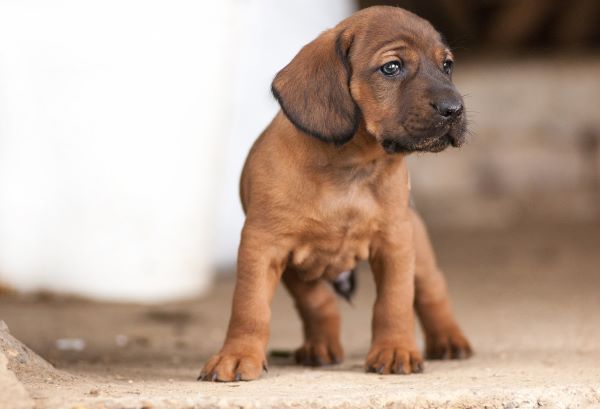
Bloodhound feeding and nutrition
The Bloodhound should be fed a premium, high-quality dog food appropriate to the dog’s age (puppy, adult, or senior), size and activity level.
Bloodhounds are notorious for eating anything and everything, which can sometimes lead to panicked vet visits. Prospective owners beware, they eat a lot and their monthly food costs can be pretty high!
Because Bloat and/or Torsion is a concern with this breed, avoid free feeding or feeding just one large meal, and instead split meals, feeding 2 to 3 times a day for an adult dog.
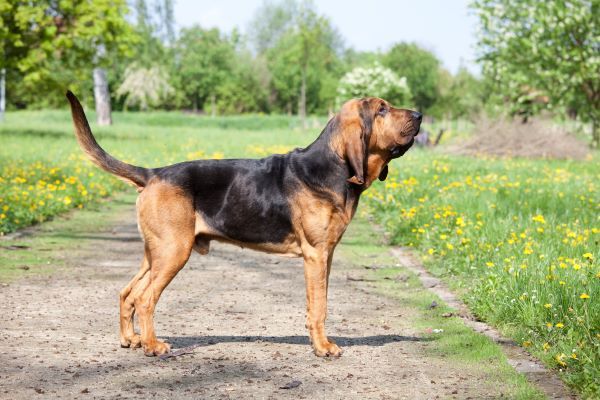
Bloodhound care and grooming
The Bloodhound has a short, dense, waterproof coat that sheds once or twice a year. Weekly brushing with a medium-bristle brush, a rubber grooming mitt or tool, or a hound glove will remove the dead hair and keep the coat maintained. Brushing also promotes new hair growth and distributes skin oils throughout the coat to keep it healthy. They should be bathed regularly, especially in the warmer months, to keep them from developing a doggy odour.
Bloodhounds are droolers. Their skin folds should be checked daily for odour or irritation, and if needed, wiped with a warm, wet cloth and then dried thoroughly. The Bloodhound’s low-hanging ears should be checked daily for any sign of infection. Wearing a snood at meal times can help keep their ears out of the food bowl.
Health issues for Bloodhounds
- Gastric Torsion, also know as bloat, is a condition that affects large, deep-chested breeds like the Bloodhound. It occurs when a gas-filled stomach flips over on itself, twisting the opening to the oesophaegus and intestines. Without immediate veterinary care, the affected dog will die a very painful death.
- Hip dysplasia and Elbow dysplasia are inherited conditions which occur when the ball and socket of the affected joint do not fit together properly. As these conditions can cause painful arthritis in the joint later in the dog’s life, it is essential to begin management and/or treatment of the condition as soon as possible. For elbow dysplasia, surgery may be recommended.
 Degenerative Myelopathy is a disease that affects the spinal cord in dogs, causing progressive hind limb muscle weakness and loss of coordination. Affected dogs gradually becoming incontinent and losing the ability to walk. The condition is ultimately fatal.
Degenerative Myelopathy is a disease that affects the spinal cord in dogs, causing progressive hind limb muscle weakness and loss of coordination. Affected dogs gradually becoming incontinent and losing the ability to walk. The condition is ultimately fatal.- Congenital heart disease is genetic and is the malformation of valves in the heart, causing serious problems that will often result in death within the first year of life. Dogs with a milder forms of the condition will mostly survive but will show a tendency to avoid exercise, may have stunted growth or will occasionally faint. Cardiac arrest can occur at any time, but in most cases later in life.
- Skin problems such as itchiness and rashes can occur, particularly within the deep skin folds of the Bloodhound.
- Eye problems such as Entropion and Ectropion can be a problem for the breed. Entropion is a congenital condition in which the eyelids appear to roll inward against the cornea of the eye; this can cause a great deal of discomfort for the animal. With ectropion, the eyelids roll outward.
Not all conditions are covered by Pet Insurance. For details of Bow Wow Meow Pet Insurance cover, refer to the Product Disclosure Statement.
Free engraved pet ID tag on sign up3
Customer Satisfaction
21 day cooling off
Easy to use Pet Portal


